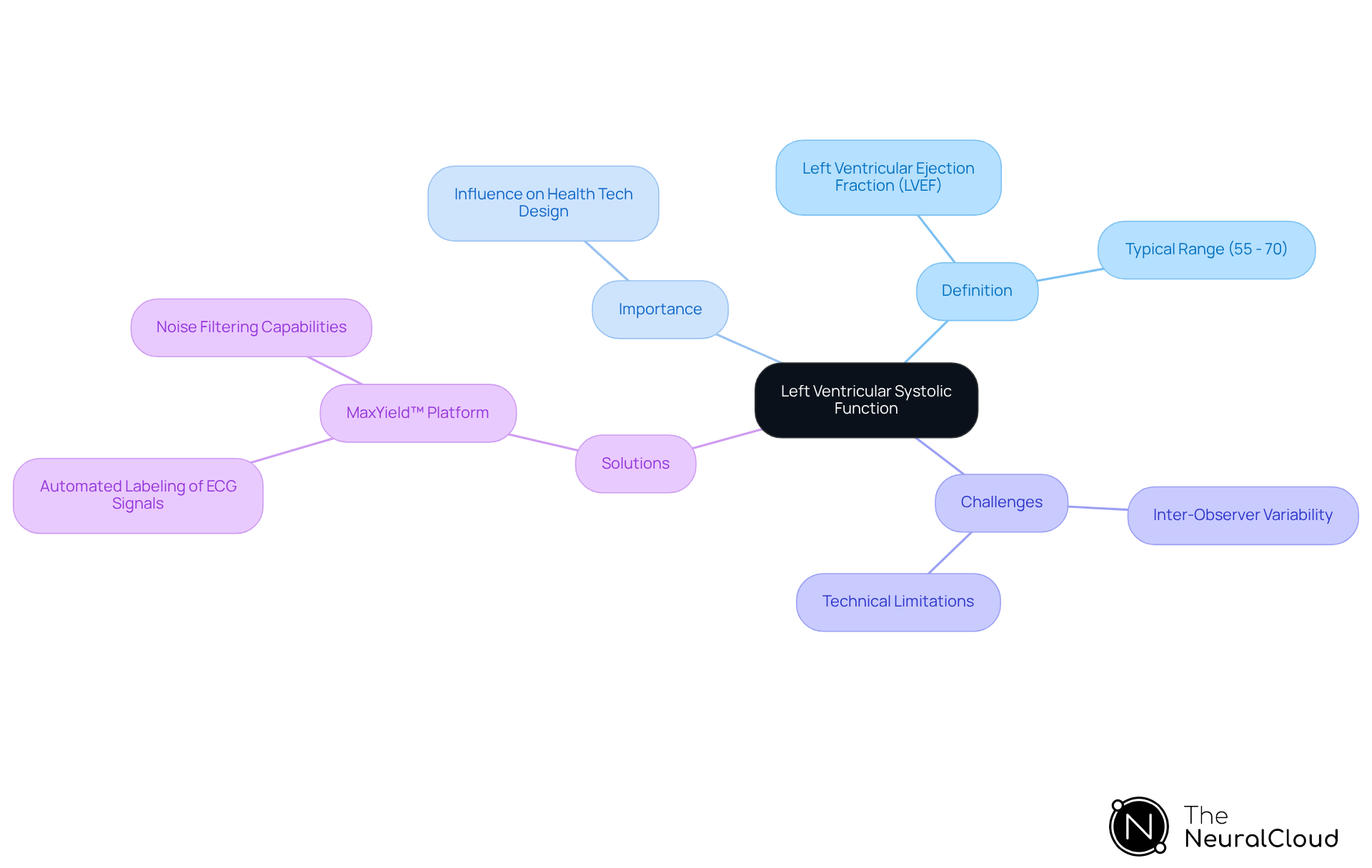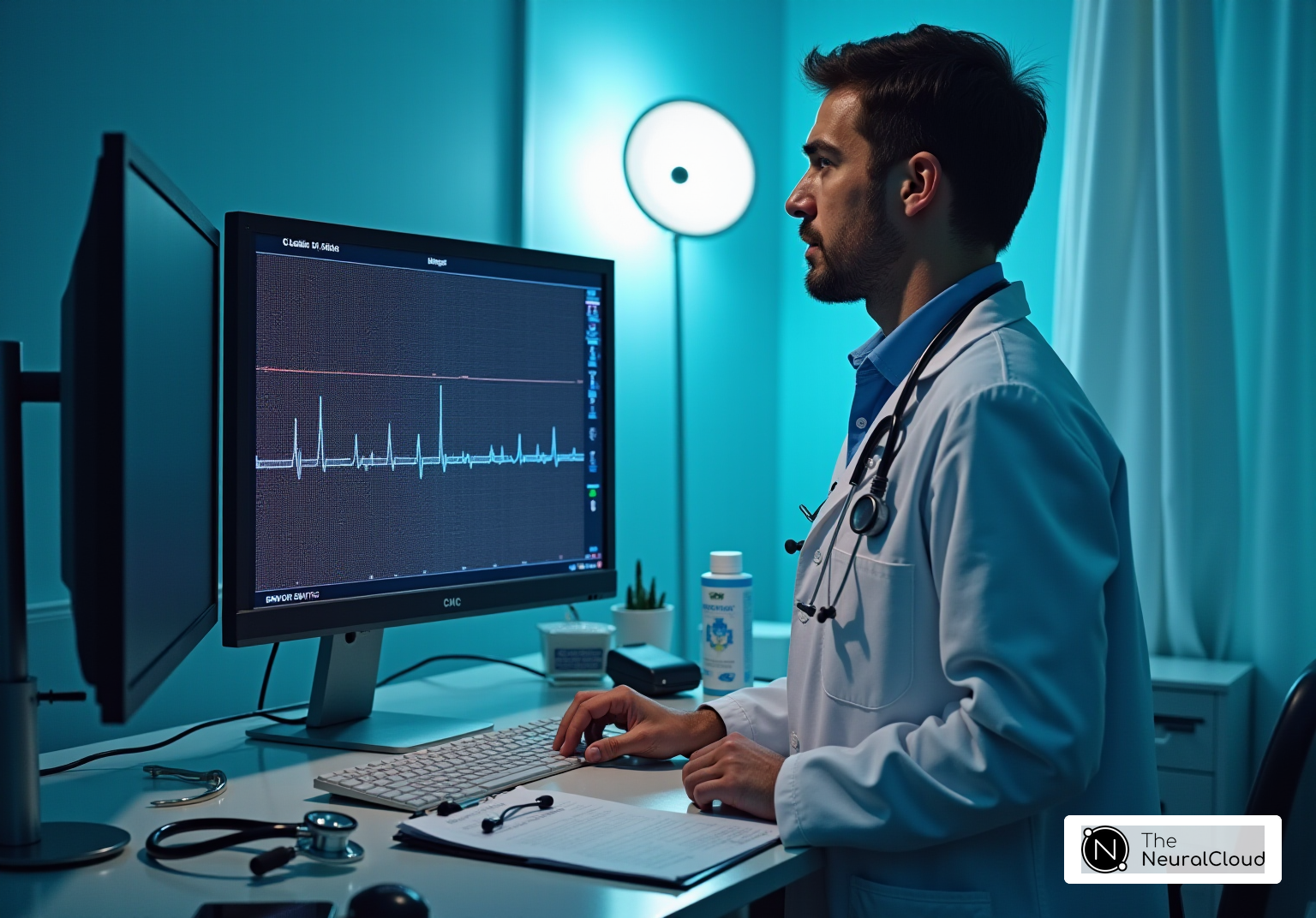Overview
The article emphasizes the importance of left ventricular (LV) systolic function, particularly its assessment through left ventricular ejection fraction (LVEF), in the diagnosis and management of cardiovascular health, especially in heart failure cases. It outlines the challenges faced in ECG analysis, such as inter-observer variability and the limitations of static classifications, which can hinder effective monitoring of cardiovascular conditions.
To address these challenges, innovative health tech solutions like Neural Cloud Solutions' MaxYield™ platform are highlighted. This platform offers advanced features that enhance the accuracy and efficiency of LVEF assessments, thus improving overall cardiovascular care. By leveraging cutting-edge technology, MaxYield™ aims to streamline the assessment process, providing healthcare professionals with reliable data to inform their clinical decisions.
The advantages of the MaxYield™ platform extend beyond mere functionality. By improving ECG analysis, it enables healthcare providers to deliver better patient outcomes through more precise monitoring and management of heart conditions. This is particularly beneficial in complex cases where traditional methods may fall short, allowing for a more nuanced understanding of a patient's cardiovascular health.
In conclusion, the integration of the MaxYield™ platform into clinical practice represents a significant advancement in the field of cardiovascular health. By addressing existing challenges and enhancing the assessment of LV systolic function, it empowers healthcare professionals to make informed decisions, ultimately improving patient care.
Introduction
Understanding left ventricular systolic function is essential for clinicians and health tech developers, as it is a key factor in diagnosing and managing cardiovascular diseases. The left ventricular ejection fraction (LVEF) is a critical measure of this function, providing insights into cardiac performance and patient outcomes.
However, the challenge arises from the evolving nature of LVEF assessments, which require innovative approaches for accurate monitoring and interpretation of these vital metrics. This raises the question: how can health tech innovations effectively bridge the gap between traditional methods and the dynamic demands of modern cardiac care?
Define Left Ventricular Systolic Function
Lv systolic function refers to the ability of the left ventricle to contract and pump blood effectively during systole, the phase of the heartbeat when the heart muscle contracts. The primary indicator of this process is the left ventricular ejection fraction (LVEF), which quantifies the percentage of blood expelled from the ventricle with each heartbeat. A typical LVEF ranges from 55% to 70%, indicating efficient cardiac performance. Understanding this function is essential for health tech developers as it directly influences the design and functionality of diagnostic tools aimed at assessing cardiac health.
Recent research highlights the dynamic nature of LVEF, suggesting that a static classification may not fully reflect the progression of cardiovascular conditions. As noted by John Teerlink, the static categorization of heart failure based on a single LVEF cut-off doesn’t capture the dynamic progression or response to therapy in many patients. This emphasizes the necessity for innovative methods in monitoring and assessment, especially considering ongoing challenges in evaluating lv systolic function, such as technical limitations and inter-observer variability.
Neural Cloud Solutions' MaxYield™ platform addresses these challenges by leveraging a Continuous Learning Model that enhances ECG analysis accuracy and efficiency. Key features of MaxYield™ include:
- Automated labeling of ECG signals, which minimizes human error.
- Noise filtering capabilities that improve signal clarity.
These features provide significant advantages for healthcare professionals, including clearer insights into cardiac performance and more reliable assessments of patient conditions. Integrating findings from recent research and case analyses, such as the reevaluation of LVEF in cardiac failure, can further demonstrate the advancing comprehension of LVEF and its clinical ramifications.

Explore Clinical Importance of LV Systolic Function
The importance of LV systolic function in diagnosing and managing cardiovascular issues, particularly heart failure, is paramount. A decreased left ventricular ejection fraction (LVEF) correlates with increased morbidity and mortality risks, highlighting its significance in patient evaluations. Clinicians rely on accurate measurements of LV systolic function to inform treatment strategies, monitor disease progression, and evaluate the effectiveness of therapeutic interventions. Recent guidelines stress the necessity for a nuanced understanding of left ventricular ejection fraction, advocating for a trajectory-based approach rather than static categorizations. This transition facilitates more personalized treatment decisions, as LVEF trajectories provide improved prognostic insights.
For health tech developers, the challenge is to create innovative tools that enhance the accuracy and efficiency of LV function assessments. Neural Cloud Solutions' MaxYield™ platform features advanced noise filtering and wave recognition capabilities, enabling rapid labeling of P, QRS, and T Wave onsets and offsets. This innovative ECG signal analysis allows for beat-by-beat tabulation in CSV format, facilitating straightforward integration into existing workflows. By automating repetitive tasks and processing more data in less time, MaxYield™ addresses inefficiencies, physiological variability, and signal artifacts that often complicate ECG analysis.
Emerging technologies such as strain imaging and AI-driven automation are revolutionizing cardiac diagnostics, promising improved outcomes for patients and streamlined clinical workflows. Case studies indicate that among young individuals experiencing their first myocardial infarction:
- 42% with an abnormal baseline EF returned to normal levels within six months, resulting in an approximately eight-fold decrease in all-cause mortality.
This underscores the critical need for prompt and precise evaluations of LV systolic function to enhance patient care and treatment strategies. Furthermore, addressing the limitations of current LVEF-based classification systems is vital for improving diagnostic precision and treatment approaches concerning LV systolic function.

Assess Techniques for Evaluating LV Systolic Function
Several techniques are employed to evaluate LV systolic function, each with its advantages and limitations. The most common methods include:
-
Echocardiography: This non-invasive imaging method is commonly utilized to evaluate left ventricular ejection fraction and offers real-time visualization of cardiac structures. The biplane Simpson method is often recommended for its accuracy in measuring LV volumes. Research suggests that echocardiographic left ventricular ejection fractions are generally lower than those acquired via angiography, with a sensitivity of 86% for detecting reduced left ventricular ejection fractions. Kishore Boga, a cardiac physiologist, emphasizes that 'LV systolic function, especially left ventricular ejection fraction (LVEF), is a critical parameter in guiding clinical decisions.'
-
Cardiac Magnetic Resonance Imaging (CMR): CMR is considered the gold standard for assessing LV systolic function due to its high spatial resolution and ability to provide detailed anatomical information. It is especially beneficial in intricate situations where echocardiography might be restricted, such as in individuals with poor acoustic windows or considerable obesity.
-
Radionuclide Ventriculography: This technique involves the injection of a radioactive tracer to visualize the heart's pumping action. It is less commonly used but can provide valuable information in specific clinical scenarios, particularly when other imaging modalities are inconclusive.
-
Computed Tomography (CT): CT can be employed to evaluate LV performance, especially in individuals with coronary artery disease. However, its use is restricted by radiation exposure and the requirement for contrast agents, which may not be appropriate for everyone.
-
Invasive Hemodynamic Monitoring: In certain critical cases, direct measurement of pressures within the heart can provide essential insights into LV systolic function. This method is especially beneficial in critically unwell individuals where accurate hemodynamic information is vital for management.
For health tech developers, understanding these techniques is crucial for designing tools that can either complement existing methods or offer innovative solutions to enhance diagnostic accuracy. Recent developments, including the incorporation of AI in echocardiography and the creation of the EchoNet-Measurements model, are expected to enhance the accuracy of left ventricular ejection fraction evaluations and simplify clinical workflows.

Interpret Results and Implications for Patient Management
Analyzing the outcomes of evaluations regarding LV systolic function is essential for directing care. An average left ventricular ejection fraction signifies sufficient cardiac performance, whereas a diminished LV systolic function (below 55%) implies possible cardiac failure or other cardiovascular issues. Clinicians must consider these results alongside other clinical findings and individual history to develop an appropriate management plan.
Treatment Choices: Individuals with decreased LVEF may need drugs like ACE inhibitors, beta-blockers, or diuretics to address failure symptoms and enhance results. The 2022 Heart Failure Guidelines highlight the significance of guideline-directed medical therapy (GDMT) for all patients with cardiovascular failure, which includes these medications as essential treatments. Additionally, SGLT2 inhibitors have been shown to provide cardiovascular benefits for heart failure management, regardless of diabetes status.
Monitoring Progression: Regular evaluation of LV performance is crucial for tracking disease advancement and assessing the effectiveness of treatment strategies. This continuous oversight enables clinicians to make prompt modifications to therapy, ensuring optimal care for individuals.
Risk Stratification: Comprehending a person's LV performance assists in categorizing risk for negative outcomes, directing choices about additional diagnostic assessments or interventions. For example, individuals with markedly decreased left ventricular ejection fraction may need more rigorous observation and possible referral to specialized treatment.
Client Education: Healthcare providers can utilize LV performance outcomes to inform individuals about their condition, promoting improved adherence to treatment strategies and lifestyle changes. Efficient dialogue regarding the consequences of decreased LV systolic function promotes a cooperative strategy for managing cardiovascular well-being.
For health tech developers, creating tools that facilitate accurate interpretation of LV function results can enhance clinical decision-making and ultimately improve patient care. By integrating advanced analytics and user-friendly interfaces, developers can support healthcare professionals in delivering high-quality cardiac care. Furthermore, with the expected rise in heart failure cases to 8 million by 2030, the urgency for effective LVEF management is paramount.

Conclusion
Understanding left ventricular (LV) systolic function is crucial for advancing health technology and improving patient outcomes. This article delves into the significance of LV systolic function, particularly the left ventricular ejection fraction (LVEF), as a vital indicator of cardiac health. By embracing innovative tools and methodologies, health tech developers can enhance diagnostic accuracy and efficiency, ultimately leading to better management of cardiovascular conditions.
Key insights presented include:
- The dynamic nature of LVEF
- The importance of tailored treatment strategies
- The various techniques for evaluating LV systolic function
The article also highlights the role of advanced technologies, such as Neural Cloud Solutions' MaxYield™ platform, in overcoming traditional assessment challenges. These developments underscore the necessity for continuous improvement in monitoring and interpreting LV function to inform clinical decisions effectively.
As cardiovascular diseases continue to rise, the urgency for precise and efficient evaluations of LV systolic function becomes ever more critical. Health tech developers are encouraged to innovate and integrate advanced analytics into their solutions, ensuring that healthcare professionals are equipped to provide optimal care. By prioritizing the understanding and assessment of LV systolic function, the potential for enhanced patient outcomes and improved healthcare delivery is significant.
Frequently Asked Questions
What is left ventricular systolic function?
Left ventricular systolic function refers to the ability of the left ventricle to contract and pump blood effectively during systole, which is the phase of the heartbeat when the heart muscle contracts.
What is the primary indicator of left ventricular systolic function?
The primary indicator is the left ventricular ejection fraction (LVEF), which quantifies the percentage of blood expelled from the ventricle with each heartbeat.
What is a typical range for left ventricular ejection fraction (LVEF)?
A typical LVEF ranges from 55% to 70%, indicating efficient cardiac performance.
Why is understanding left ventricular systolic function important for health tech developers?
Understanding this function is essential for health tech developers as it directly influences the design and functionality of diagnostic tools aimed at assessing cardiac health.
What recent findings highlight the dynamic nature of LVEF?
Recent research suggests that a static classification of heart failure based on a single LVEF cut-off may not fully reflect the progression of cardiovascular conditions or response to therapy.
What challenges exist in evaluating left ventricular systolic function?
Ongoing challenges include technical limitations and inter-observer variability in assessments.
How does Neural Cloud Solutions' MaxYield™ platform address challenges in ECG analysis?
MaxYield™ enhances ECG analysis accuracy and efficiency through a Continuous Learning Model, which includes automated labeling of ECG signals to minimize human error and noise filtering capabilities to improve signal clarity.
What advantages does MaxYield™ provide for healthcare professionals?
The platform offers clearer insights into cardiac performance and more reliable assessments of patient conditions.
How does recent research contribute to the understanding of LVEF and its clinical implications?
Integrating findings from recent research and case analyses, such as the reevaluation of LVEF in cardiac failure, demonstrates the advancing comprehension of LVEF and its clinical ramifications.






